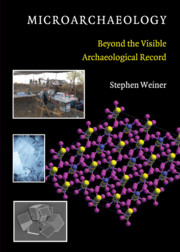Book contents
- Frontmatter
- Contents
- Preface
- 1 Archaeology, Archaeological Science, and Microarchaeology
- 2 Information Embedded in the Microscopic Record
- 3 Completeness of the Archaeological Record
- 4 Common Mineral Components of the Archaeological Record
- 5 Biological Materials: Bones and Teeth
- 6 Biological Materials: Phytoliths, Diatoms, Eggshells, Otoliths, and Mollusk Shells
- 7 Reconstructing Pyrotechnological Processes
- 8 Biological Molecules and Macromolecules: Protected Niches
- 9 Ethnoarchaeology of the Microscopic Record: Learning from the Present
- 10 Absolute Dating: Assessing the Quality of a Date
- 11 Reading the Microscopic Record On-Site
- 12 Infrared Spectroscopy in Archaeology
- Appendix A Identifying Minerals Using Microchemical Analysis
- Appendix B Identifying Minerals and Compounds Using Infrared Spectra: Table of Standard Minerals and Compounds for Which Infrared Spectra Are Available
- References
- Index
- Plates section
5 - Biological Materials: Bones and Teeth
Published online by Cambridge University Press: 05 June 2012
- Frontmatter
- Contents
- Preface
- 1 Archaeology, Archaeological Science, and Microarchaeology
- 2 Information Embedded in the Microscopic Record
- 3 Completeness of the Archaeological Record
- 4 Common Mineral Components of the Archaeological Record
- 5 Biological Materials: Bones and Teeth
- 6 Biological Materials: Phytoliths, Diatoms, Eggshells, Otoliths, and Mollusk Shells
- 7 Reconstructing Pyrotechnological Processes
- 8 Biological Molecules and Macromolecules: Protected Niches
- 9 Ethnoarchaeology of the Microscopic Record: Learning from the Present
- 10 Absolute Dating: Assessing the Quality of a Date
- 11 Reading the Microscopic Record On-Site
- 12 Infrared Spectroscopy in Archaeology
- Appendix A Identifying Minerals Using Microchemical Analysis
- Appendix B Identifying Minerals and Compounds Using Infrared Spectra: Table of Standard Minerals and Compounds for Which Infrared Spectra Are Available
- References
- Index
- Plates section
Summary
Biologically produced mineralized materials are an important component of the archaeological record. The most common biogenic materials found in archaeological sites are bones, teeth, mollusk shells, eggshells, otoliths, and plant phytoliths. The fact that they are mineralized greatly increases their chances of being preserved, and as they are biologically produced, they contain much embedded information of interest to archaeology.
BIOMINERALIZATION: ARCHAEOLOGICAL PERSPECTIVE
The biogenic mineralized materials common in archaeological sites are part of a much larger group of mineralized materials produced by a wide variety of organisms, ranging from bacteria to man (for overviews, see Lowenstam and Weiner, 1989; Simkiss and Wilbur, 1989; Dove et al., 2003). More than 65 different minerals are known to be produced biologically. These include minerals that, at the atomic level, are highly disordered such as amorphous silica (opal), amorphous calcium carbonate, and amorphous calcium phosphate. Most biogenic minerals are relatively ordered at the atomic level and are thus crystalline. Common crystalline biogenic minerals include the carbonate minerals (such as calcite, aragonite, vaterite, and monohydrocalcite), the calcium phosphate mineral carbonated apatite, oxides (such as the magnetic mineral magnetite), calcium oxalates, and more. For a partial list, see Appendix B. Biogenic minerals usually have shapes that are quite distinct from their inorganic counterparts and are often aligned into arrays. Biogenic mineral assemblies almost always have intimately associated organic components, some of which are responsible for controlling mineral formation.
The mineralization process, like all biological processes, is orchestrated by cells.
- Type
- Chapter
- Information
- MicroarchaeologyBeyond the Visible Archaeological Record, pp. 99 - 134Publisher: Cambridge University PressPrint publication year: 2010
- 1
- Cited by



